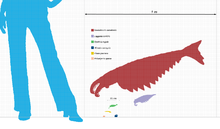Peytoia
| Peytoia Temporal range: Early Cambrian | |
|---|---|
 | |
| Fossil specimen, Royal Ontario Museum | |
| | |
| Reconstruction | |
| Scientific classification | |
| Kingdom: | Animalia |
| Class: | †Dinocaridida |
| Order: | †Radiodonta |
| Family: | †Hurdiidae |
| Genus: | †Peytoia Walcott, 1911 |
| Type species | |
| †Peytoia nathorsti Walcott, 1911 | |
| Species | |
| |
| Synonyms | |
| |
Peytoia is a genus of anomalocarids that lived in the Cambrian period, containing two species, Peytoia nathorsti and Peytoia infercambriensis.[1] Its two mouth appendages had long bristle-like spines, it had no fan tail, and its short stalked eyes were behind its mouth appendages.
Paleontologists have determined that these attributes disqualify Peytoia from apex predator status (as opposed to Anomalocaris), to the extent that it used its appendages to filter water and sediment on the sea floor to find food.[2]
108 specimens of Peytoia are known from the Greater Phyllopod bed, where they comprise 0.21% of the community.[3]
Classification
Peytoia belongs to the clade Hurdiidae, and is closely related to the contemporary genus Hurdia.[4]
History

The history of Peytoia is entangled with that of "Laggania" and Anomalocaris: all three were initially identified as isolated body parts and only later discovered to belong to one type of animal. This was due in part due to their makeup of a mixture of mineralized and unmineralized body parts; the mouth and feeding appendage were considerably harder and more easily fossilized than the delicate body.[5]
The first was a detached 'arm', described by Joseph Frederick Whiteaves in 1892 as a crustacean-like creature, because it resembled the tail of a lobster or shrimp.[5] The first fossilized mouth was discovered by Charles Doolittle Walcott, who mistook it for a jellyfish and placed it in the genus Peytoia. The body was discovered separately and classified as a sponge in the genus Laggania; the mouth was found with the body, but was interpreted by its discoverer Simon Conway Morris as an unrelated Peytoia that had settled and been preserved with the "Laggania". Later, while clearing what he thought was an unrelated specimen, Harry B. Whittington removed a layer of covering stone to discover the unequivocally connected arm thought to be a shrimp tail and the mouth thought to be a jellyfish.[6][5] Whittington linked the two species, but it took several more years for researchers to realize that the continuously juxtaposed Peytoia, Laggania and feeding appendage represented one enormous creature.[5] Laggania and Peytoia were named in the same publication, but Simon Conway Morris selected Peytoia as the valid name in 1978, which makes it the valid name according to International Commission on Zoological Nomenclature rules.[7][8]
External links
- "Laggania cambria". Burgess Shale Fossil Gallery. Virtual Museum of Canada. 2011.
References
- ↑ Daley, A. C.; Legg, D. A. (2015). "A morphological and taxonomic appraisal of the oldest anomalocaridid from the Lower Cambrian of Poland". Geological Magazine. 152 (5): 949–955. doi:10.1017/S0016756815000412.
- ↑ Dzik, J.; Lendzion, K. (1988). "The Oldest Arthropods of the East European Platform.". Lethaia. 21: 29–38. doi:10.1111/j.1502-3931.1988.tb01749.x.
- ↑ Caron, Jean-Bernard; Jackson, Donald A. (October 2006). "Taphonomy of the Greater Phyllopod Bed community, Burgess Shale". PALAIOS. 21 (5): 451–65. JSTOR 20173022. doi:10.2110/palo.2003.P05-070R.
- ↑ Vinther, J.; Stein, M.; Longrich, N. R.; Harper, D. A. T. (2014). "A suspension-feeding anomalocarid from the Early Cambrian". Nature. 507: 497–499. PMID 24670770. doi:10.1038/nature13010.
- 1 2 3 4 Gould, Stephen Jay (1989). Wonderful life: the Burgess Shale and the nature of history. New York: W.W. Norton. pp. 194–206. ISBN 0-393-02705-8.
- ↑ Conway Morris, S. (1998). The crucible of creation: the Burgess Shale and the rise of animals. Oxford [Oxfordshire]: Oxford University Press. pp. 56–9. ISBN 0-19-850256-7.
- ↑ Conway Morris, S. (1978). "Laggania cambria Walcott: A composite fossil". Journal of Paleontology. 52 (1): 126–131.
- ↑ Daley, A. and Bergström, J. (2012). "The oral cone of Anomalocaris is not a classic 'peytoia'." Naturwissenschaften, doi:10.1007/s00114-012-0910-8